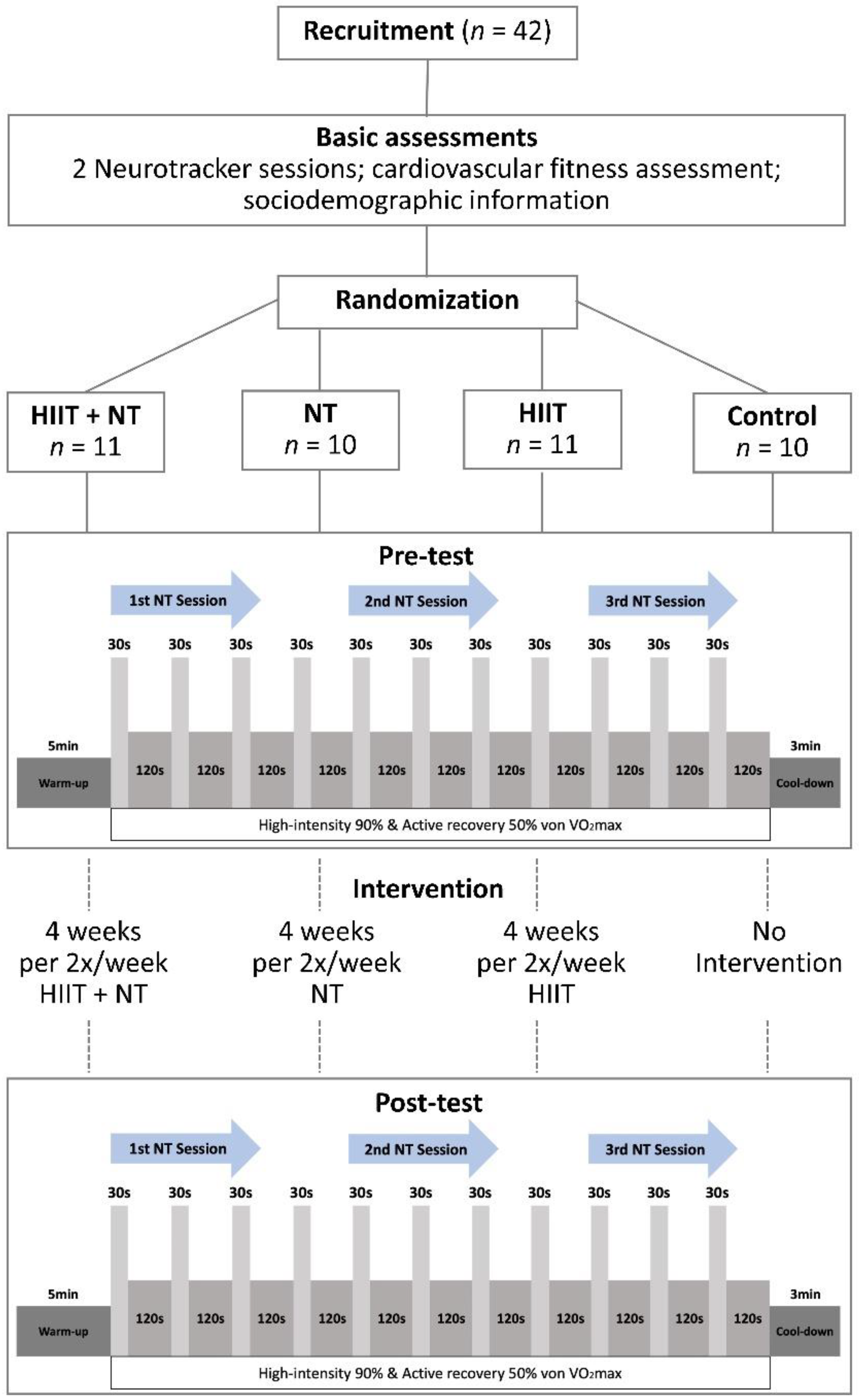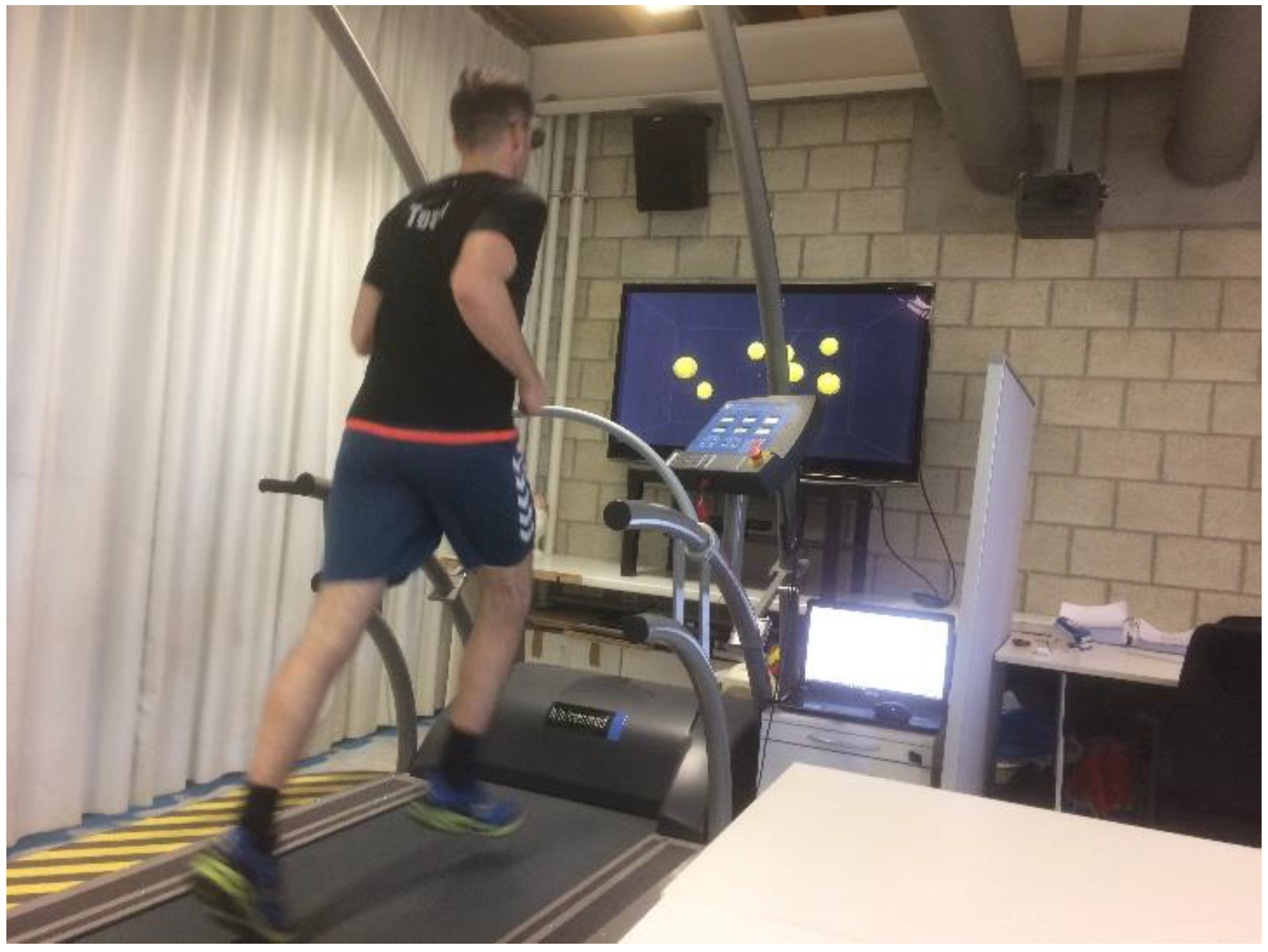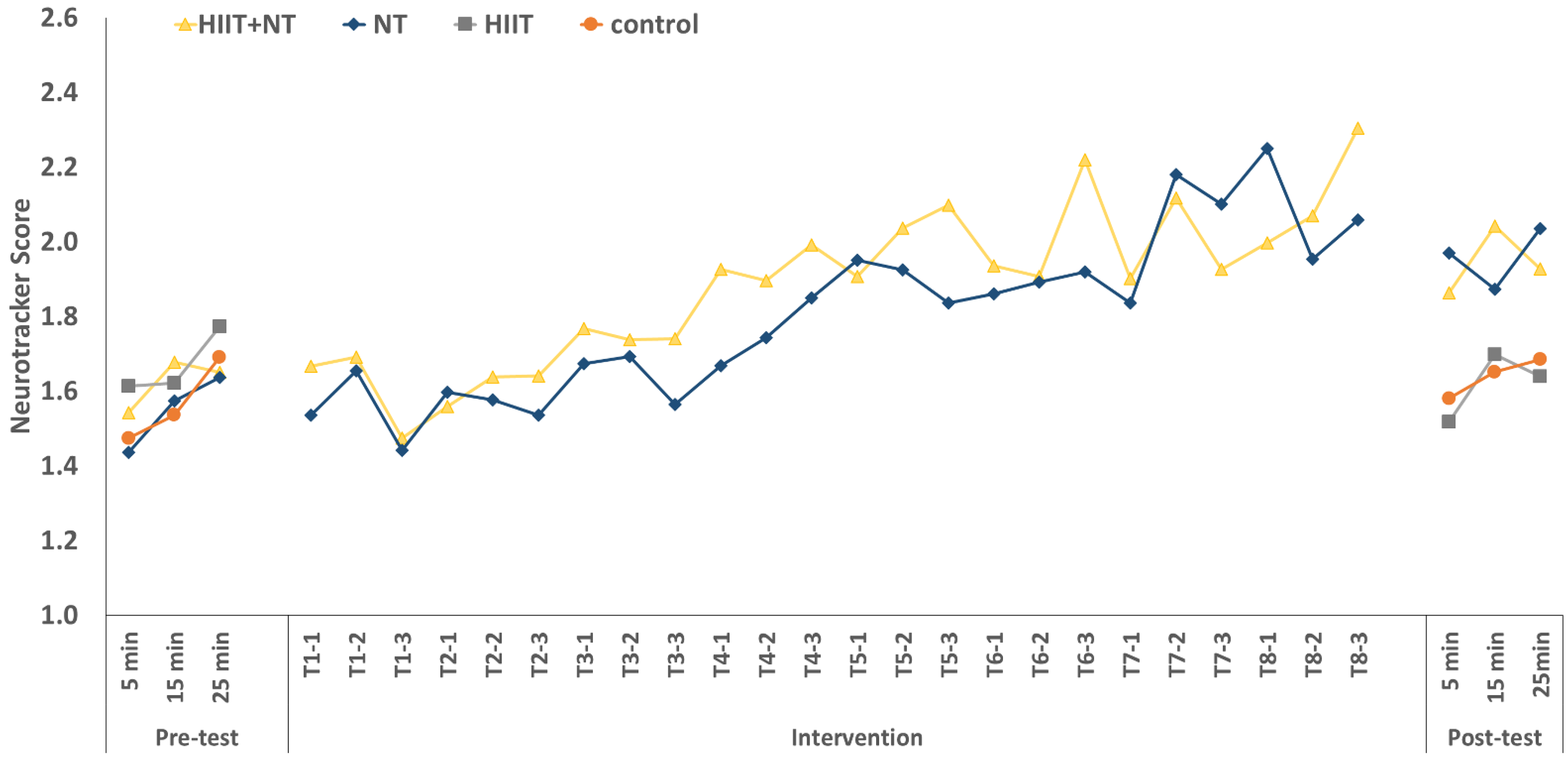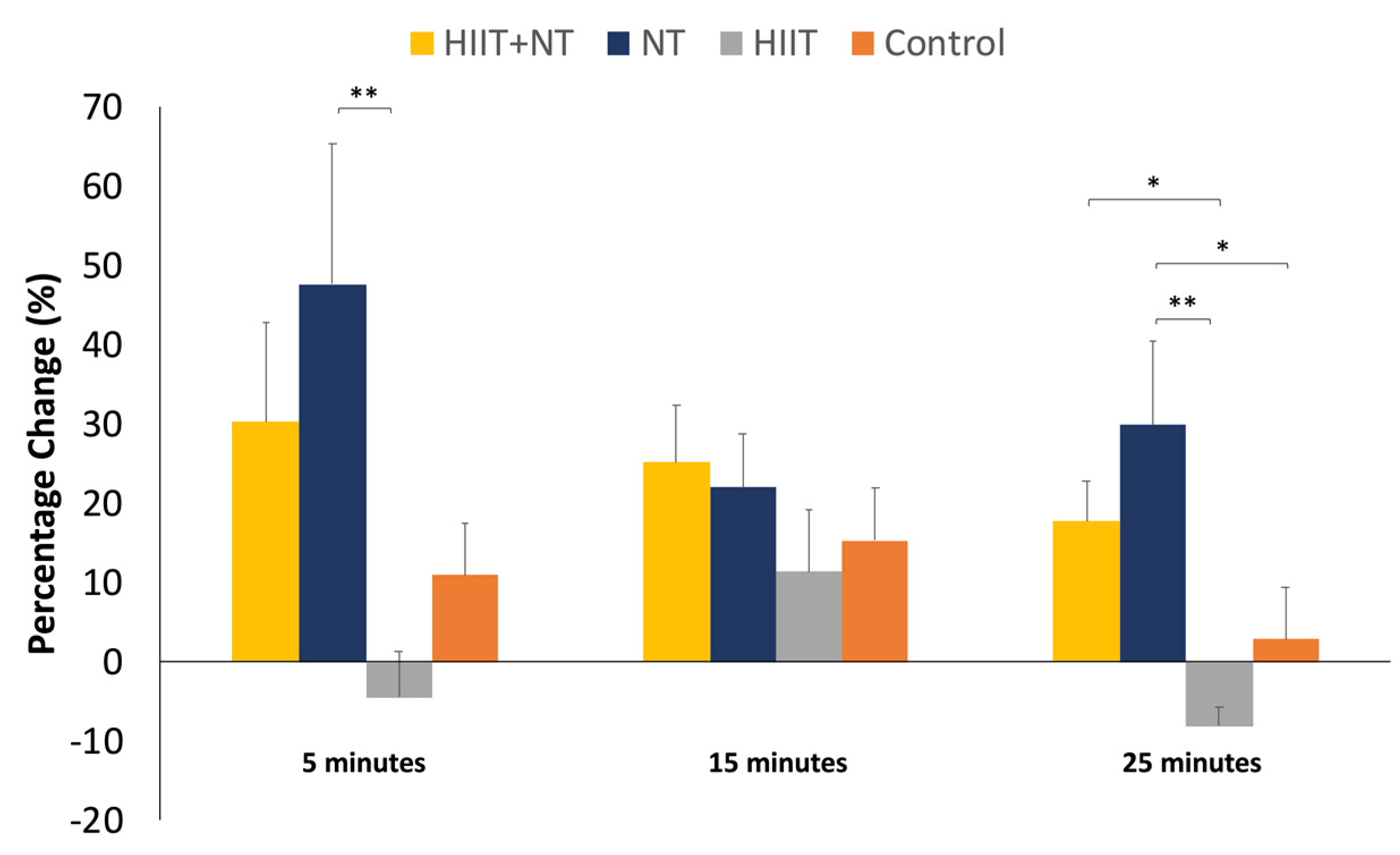The Effects of the Combination of High-Intensity Interval Training with 3D-Multiple Object Tracking Task on Perceptual-Cognitive Performance: A Randomized Controlled Intervention Trial
Abstract
1. Introduction
2. Materials and Methods
2.1. Participants
2.2. Experimental Design and Procedure
2.3. Intervention
2.4. Demographic Information, BMI, Physical Activity, and Mental/Physical Fatigue
2.5. 3D-Multiple Object Tracking Task
2.6. Maximum Oxygen Uptake (VO2max) and Running Speed
2.7. Data Analysis
3. Results
3.1. Characteristics of the Study Population
3.2. Change Rate of MPSTEFS in Pre-and Post-Test
3.3. Maximum Oxygen Uptake (VO2max)
3.4. NT Performance during HIIT in Pre-Test
3.5. Long-Term Effects on NT Performance during HIIT after Intervention
4. Discussion
4.1. The Importance of Combining Physical Exercise with Perceptual–Cognitive Training
4.2. Implications for Future Research and Practice
5. Conclusions
Author Contributions
Funding
Institutional Review Board Statement
Informed Consent Statement
Data Availability Statement
Acknowledgments
Conflicts of Interest
References
- Bullock, T.; Giesbrecht, B. Acute Exercise and Aerobic Fitness Influence Selective Attention during Visual Search. Front. Psychol. 2014, 5, 1–11. [Google Scholar] [CrossRef]
- Schapschröer, M.; Lemez, S.; Baker, J.; Schorer, J. Physical Load Affects Perceptual-Cognitive Performance of Skilled Athletes: A Systematic Review. Sport. Med. Open 2016, 2, 37. [Google Scholar] [CrossRef] [PubMed]
- Hüttermann, S.; Memmert, D. Does the Inverted-U Function Disappear in Expert Athletes? An Analysis of the Attentional Behavior under Physical Exercise of Athletes and Non-Athletes. Physiol. Behav. 2014, 131, 87–92. [Google Scholar] [CrossRef] [PubMed]
- Hadlow, S.M.; Panchuk, D.; Mann, D.L.; Portus, M.R.; Abernethy, B. Modified Perceptual Training in Sport: A New Classification Framework. J. Sci. Med. Sport 2018, 21, 950–958. [Google Scholar] [CrossRef] [PubMed]
- Bherer, L.; Peterson, M.S.; Kramer, A.F.; Colcombe, S.; Erickson, K.; Becic, E. Training Effects on Dual-Task Performance: Are There Age-Related Differences in Plasticity of Attentional Control? Psychol. Aging 2005, 20, 695–709. [Google Scholar] [CrossRef] [PubMed]
- Voss, M.W.; Kramer, A.F.; Basak, C.; Prakash, R.S.; Roberts, B. Are Expert Athletes “expert” in the Cognitive Laboratory? A Meta-Analytic Review of Cognition and Sport Expertise. Appl. Cogn. Psychol. 2010, 24, 812–826. [Google Scholar] [CrossRef]
- Faubert, J.; Sidebottom, L. Perceptual-Cognitive Training of Athletes. J. Clin. Sport Psychol. 2012, 6, 85–102. [Google Scholar] [CrossRef]
- Faubert, J. Professional Athletes Have Extraordinary Skills for Rapidly Learning Complex and Neutral Dynamic Visual Scenes. Sci. Rep. 2013, 3, 1154. [Google Scholar] [CrossRef] [PubMed]
- Romeas, T.; Guldner, A.; Faubert, J. 3D-Multiple Object Tracking Training Task Improves Passing Decision-Making Accuracy in Soccer Players. Psychol. Sport Exerc. 2016, 22, 1–9. [Google Scholar] [CrossRef]
- Fougnie, D.; Marois, R. Distinct Capacity Limits for Attention and Working Memory: Evidence from Attentive Tracking and Visual Working Memory Paradigms. Psychol. Sci. 2006, 17, 526–534. [Google Scholar] [CrossRef]
- Legault, I.; Allard, R.; Faubert, J. Healthy Older Observers Show Equivalent Perceptual-Cognitive Training Benefits to Young Adults for Multiple Object Tracking. Front. Psychol. 2013, 4, 323. [Google Scholar] [CrossRef] [PubMed]
- Parsons, B.; Magill, T.; Boucher, A.; Zhang, M.; Zogbo, K.; Berube, S.; Scheffer, O.; Beauregard, M.; Faubert, J. Enhancing Cognitive Function Using Perceptual-Cognitive Training. Clin. Eeg Neurosci. 2014, 47, 1–11. [Google Scholar] [CrossRef] [PubMed]
- Quevedo, L.; Padrós, A.; Solé, J.; Cardona, G. Entrenament Perceptivocognitiu Amb El Neurotracker 3D-MOT per Potenciar El Rendimient En Tres Modalitats Esportives. Apunt. Educ. Física Y Deport. 2015, 119, 97–108. [Google Scholar] [CrossRef]
- Fernandes, M.; de Sousa, A.; Medeiros, A.R.; Del Rosso, S.; Stults-Kolehmainen, M.; Boullosa, D.A. The Influence of Exercise and Physical Fitness Status on Attention: A Systematic Review. Int. Rev. Sport Exerc. Psychol. 2019, 12, 202–234. [Google Scholar] [CrossRef]
- Alesi, M.; Bianco, A.; Luppina, G.; Palma, A.; Pepi, A. Improving Children’s Coordinative Skills and Executive Functions. Percept. Mot. Ski. 2016, 122, 27–46. [Google Scholar] [CrossRef]
- Gutmann, B.; Mierau, A.; Hülsdünker, T.; Hildebrand, C.; Przyklenk, A.; Hollmann, W.; Strüder, H.K. Effects of Physical Exercise on Individual Resting State EEG Alpha Peak Frequency. Neural Plast. 2015, 2015, 1–6. [Google Scholar] [CrossRef] [PubMed]
- Hillman, C.H.; Pontifex, M.B.; Castelli, D.M.; Khan, N.A.; Raine, L.B.; Scudder, M.R.; Drollette, E.S.; Moore, R.D.; Wu, C.T.; Kamijo, K. Effects of the FITKids Randomized Controlled Trial on Executive Control and Brain Function. Pediatrics 2014, 134, e1063–e1071. [Google Scholar] [CrossRef]
- Schott, N.; Krull, K. Stability of Lifestyle Behavior—The Answer to Successful Cognitive Aging? A Comparison of Nuns, Monks, Master Athletes and Non-Active Older Adults. Front. Psychol. 2019, 10, 1–14. [Google Scholar] [CrossRef]
- Antunes, H.K.M.; De Mello, M.T.; De Aquino Lemos, V.; Santos-Galduróz, R.F.; Galdieri, L.C.; Bueno, O.F.A.; Tufik, S.; D’Almeida, V. Aerobic Physical Exercise Improved the Cognitive Function of Elderly Males but Did Not Modify Their Blood Homocysteine Levels. Dement. Geriatr. Cogn. Dis. Extra 2015, 5, 13–24. [Google Scholar] [CrossRef]
- Iuliano, E.; di Cagno, A.; Aquino, G.; Fiorilli, G.; Mignogna, P.; Calcagno, G.; Di Costanzo, A. Effects of Different Types of Physical Activity on the Cognitive Functions and Attention in Older People: A Randomized Controlled Study. Exp. Gerontol. 2015, 70, 105–110. [Google Scholar] [CrossRef]
- Del Giorno, J.M.; Hall, E.E.; O’Leary, K.C.; Bixby, W.R.; Miller, P.C. Cognitive Function during Acute Exercise: A Test of the Transient Hypofrontality Theory. J. Sport Exerc. Psychol. 2010, 32, 312–323. [Google Scholar] [CrossRef] [PubMed]
- Chang, Y.K.; Labban, J.D.; Gapin, J.I.; Etnier, J.L. The Effects of Acute Exercise on Cognitive Performance: A Meta-Analysis. Brain Res. 2012, 1453, 87–101. [Google Scholar] [CrossRef] [PubMed]
- Lambourne, K.; Tomporowski, P. The Effect of Exercise-Induced Arousal on Cognitive Task Performance: A Meta-Regression Analysis. Brain Res. 2010, 1341, 12–24. [Google Scholar] [CrossRef] [PubMed]
- Brisswalter, J.; Collardeau, M.; René, A. Effects of Acute Physical Exercise Characteristics on Cognitive Performance. Sports Med. 2002, 32, 555–566. [Google Scholar] [CrossRef] [PubMed]
- Tomporowski, P.D. Effects of Acute Bouts of Exercise on Cognition. Acta Psychol. 2003, 112, 297–324. [Google Scholar] [CrossRef]
- McMorris, T.; Sproule, J.; Turner, A.; Hale, B.J. Acute, Intermediate Intensity Exercise, and Speed and Accuracy in Working Memory Tasks: A Meta-Analytical Comparison of Effects. Physiol. Behav. 2011, 102, 421–428. [Google Scholar] [CrossRef] [PubMed]
- Casanova, F.; Garganta, J.; Silva, G.; Alves, A.; Oliveira, J.; Williams, A.M. Effects of Prolonged Intermittent Exercise on Perceptual-Cognitive Processes. Med. Sci. Sports Exerc. 2013, 45, 1610–1617. [Google Scholar] [CrossRef]
- Tsukamoto, H.; Suga, T.; Takenaka, S.; Tanaka, D.; Takeuchi, T.; Hamaoka, T.; Isaka, T.; Hashimoto, T. Greater Impact of Acute High-Intensity Interval Exercise on Post-Exercise Executive Function Compared to Moderate-Intensity Continuous Exercise. Physiol. Behav. 2016, 155, 224–230. [Google Scholar] [CrossRef]
- Tsukamoto, H.; Takenaka, S.; Suga, T.; Tanaka, D.; Takeuchi, T.; Hamaoka, T.; Isaka, T.; Hashimoto, T. Effect of Exercise Intensity and Duration on Postexercise Executive Function. Med. Sci. Sports Exerc. 2017, 49, 774–784. [Google Scholar] [CrossRef]
- Cooper, S.B.; Bandelow, S.; Nute, M.L.; Dring, K.J.; Stannard, R.L.; Morris, J.G.; Nevill, M.E. Sprint-Based Exercise and Cognitive Function in Adolescents. Prev. Med. Rep. 2016, 4, 155–161. [Google Scholar] [CrossRef]
- Lauenroth, A.; Ioannidis, A.E.; Teichmann, B. Influence of Combined Physical and Cognitive Training on Cognition: A Systematic Review. BMC Geriatr. 2016, 16, 1–14. [Google Scholar] [CrossRef] [PubMed]
- Hötting, K.; Röder, B. Beneficial Effects of Physical Exercise on Neuroplasticity and Cognition. Neurosci. Biobehav. Rev. 2013, 37, 2243–2257. [Google Scholar] [CrossRef]
- Krenn, B.; Finkenzeller, T.; Würth, S.; Amesberger, G. Sport Type Determines Differences in Executive Functions in Elite Athletes. Psychol. Sport Exerc. 2018, 38, 72–79. [Google Scholar] [CrossRef]
- Holfelder, B.; Klotzbier, T.J.; Eisele, M.; Schott, N. Hot and Cool Executive Function in Elite- and Amateur- Adolescent Athletes from Open and Closed Skills Sports. Front. Psychol. 2020, 11, 694. [Google Scholar] [CrossRef] [PubMed]
- Mélard, G. On the Accuracy of Statistical Procedures in Microsoft Excel 2010. Comp. Stat. 2014, 29, 1095–1128. [Google Scholar] [CrossRef]
- O’Connor, P.J. Mental Energy: Assessing the Mood Dimension. Nutr. Rev. Jul 2006, 64, S7–S9. [Google Scholar] [CrossRef]
- Fabri, T.L.; Wilson, K.E.; Holland, N.; Hickling, A.; Murphy, J.; Fait, P.; Reed, N. Using a Dual-Task Protocol to Investigate Motor and Cognitive Performance in Healthy Children and Youth. Gait Posture 2017, 54, 154–159. [Google Scholar] [CrossRef]
- Legault, I.; Faubert, J. Perceptual-Cognitive Training Improves Biological Motion Perception: Evidence for Transferability of Training in Healthy Aging. Neuroreport 2012, 23, 469–473. [Google Scholar] [CrossRef]
- Levitt, H. Transformed Up-down Methods in Psychoacoustics. J. Acoust. Soc. Am. 1971, 49, 467–477. [Google Scholar] [CrossRef]
- Mangine, G.T.; Hoffman, J.R.; Wells, A.J.; Gonzalez, A.M.; Rogowski, J.P.; Townsend, J.R.; Jajtner, A.R.; Beyer, K.S.; Bohner, J.D.; Pruna, G.J.; et al. Visual Tracking Speed Is Related To Basketball Basketball-Specific Measures of Performance in Nba Players. J. Strength Cond. Res. 2014, 28, 2406–2414. [Google Scholar] [CrossRef]
- Tullo, D.; Guy, J.; Faubert, J.; Bertone, A. Training with a Three-Dimensional Multiple Object-Tracking (3D-MOT) Paradigm Improves Attention in Students with a Neurodevelopmental Condition: A Randomized Controlled Trial. Dev. Sci. 2018, 21, 1–11. [Google Scholar] [CrossRef]
- Bruce, R.A. Multi-stage treadmill test of submaximal and maximal exercise. In Exercise Testing and Training of Apparently Healthy Individuals: A Handbook for Physicians; American Heart Association: Dallas, TX, USA, 1972; pp. 32–34. [Google Scholar]
- Cohen, J. Statistical Power Analysis for the Behavioral Sciences; Routledge: London, UK, 1988; ISBN 9780805802832. [Google Scholar]
- Hillman, C.H.; Erickson, K.I.; Kramer, A.F. Be Smart, Exercise Your Heart: Exercise Effects on Brain and Cognition. Nat Rev Neurosci. 2008, 9, 58–65. [Google Scholar] [CrossRef]
- Yerkes, R.M.; Dodson, J.D. The Relation of Strength of Stimulus to Rabidity of Habit-Formation. J. Comp. Neurol. Psychol. 1908, 18, 459–489. [Google Scholar] [CrossRef]
- Heywood, V. The Physical Fitness Specialist Manual, The Cooper Institute for Aerobics Research, Dallas, TX, revised 2005. In Advanced Fitness Assessment and Exercise Prescription; Heywood, V.C., Ed.; Human Kinetics: Champaign, IL, USA, 2006; pp. 52–56. [Google Scholar]
- Lövdén, M.; Schaefer, S.; Noack, H.; Bodammer, N.C.; Kühn, S.; Heinze, H.J.; Düzel, E.; Bäckman, L.; Lindenberger, U. Spatial Navigation Training Protects the Hippocampus against Age-Related Changes during Early and Late Adulthood. Neurobiol. Aging 2012, 33, 620.e9–620.e22. [Google Scholar] [CrossRef]
- Stine-Morrow, E.A.L.; Basak, C. Cognitive Interventions. In Handbook of the Psychology of Aging; Academic Press: Cambridge, MA, USA, 2011; pp. 153–171. ISBN 9780123808820. [Google Scholar]
- Heisz, J.J.; Gould, M.; McIntosh, A.R. Age-Related Shift in Neural Complexity Related to Task Performance and Physical Activity. J. Cogn. Neurosci. 2015, 27, 605–613. [Google Scholar] [CrossRef] [PubMed]
- Heisz, J.J.; Vandermorris, S.; Wu, J.; McIntosh, A.R.; Ryan, J.D. Age Differences in the Association of Physical Activity, Sociocognitive Engagement, and TV Viewing on Face Memory. Heal. Psychol. 2015, 34, 83–88. [Google Scholar] [CrossRef]
- Heisz, J.J.; Clark, I.B.; Bonin, K.; Paolucci, E.M.; Michalski, B.; Becker, S.; Fahnestock, M. The Effects of Physical Exercise and Cognitive Training on Memory and Neurotrophic Factors. J. Cogn. Neurosci. 2017, 29, 1895–1907. [Google Scholar] [CrossRef] [PubMed]
- Kempermann, G. Why New Neurons? Possible Functions for Adult Hippocampal. J. Neurosci. 2002, 22, 635–638. [Google Scholar] [CrossRef] [PubMed]
- Desjardins-Crepeau, L.; Berryman, N.; Fraser, S.A.; Vu, T.T.M.; Kergoat, M.-J.; Li, K.Z.; Bosquet, L.; Bherer, L. Effects of Combined Physical and Cognitive Training on Fitness and Neuropsychological Outcomes in Healthy Older Adults. Clin. Interv. Aging 2016, 11, 1287–1299. [Google Scholar] [CrossRef] [PubMed][Green Version]
- Law, L.L.F.; Barnett, F.; Yau, M.K.; Gray, M.A. Effects of Combined Cognitive and Exercise Interventions on Cognition in Older Adults with and without Cognitive Impairment: A Systematic Review. Ageing Res. Rev. 2014, 15, 61–75. [Google Scholar] [CrossRef] [PubMed]
- Evans, J.J.; Greenfield, E.; Wilson, B.A.; Bateman, A. Walking and Talking Therapy: Improving Cognitive-Motor Dual-Tasking in Neurological Illness. J. Int. Neuropsychol. Soc. 2009, 15, 112–120. [Google Scholar] [CrossRef] [PubMed]
- Holzschneider, K.; Wolbers, T.; Röder, B.; Hötting, K. Cardiovascular Fitness Modulates Brain Activation Associated with Spatial Learning. Neuroimage 2012, 59, 3003–3014. [Google Scholar] [CrossRef] [PubMed]
- Griffin, É.W.; Mullally, S.; Foley, C.; Warmington, S.A.; O’Mara, S.M.; Kelly, Á.M. Aerobic Exercise Improves Hippocampal Function and Increases BDNF in the Serum of Young Adult Males. Physiol. Behav. 2011, 104, 934–941. [Google Scholar] [CrossRef] [PubMed]
- Stillman, C.M.; Cohen, J.; Lehman, M.E.; Erickson, K.I. Mediators of Physical Activity on Neurocognitive Function: A Review at Multiple Levels of Analysis. Front. Hum. Neurosci. 2016, 10, 1–17. [Google Scholar] [CrossRef]





| HIIT + NT (n = 11) M (SD) | NT (n = 10) M (SD) | HIIT (n = 11) M (SD) | Control (n = 10) M (SD) | p-Value | |
|---|---|---|---|---|---|
| Sex (male:female) | 8:3 | 6:4 | 8:3 | 7:3 | 0.913 |
| Age (years) | 22.9 (2.81) | 22.7 (2.79) | 24.9 (3.86) | 22.6 (1.43) | 0.218 |
| Height (cm) | 180 (0.70) | 175 (0.12) | 176 (0.74) | 177 (0.10) | 0.600 |
| Weight (kg) | 73.6 (8.23) | 71.7 (14.0) | 67.8 (8.27) | 70.2 (13.1) | 0.662 |
| BMI (kg·m−2) | 22.7 (1.49) | 23.3 (2.16) | 21.7 (1.22) | 22.10 (2.58) | 0.290 |
| Physical activity (min/week) | 244 (111) | 258 (94.0) | 205 (42.0) | 171 (69.8) | 0.095 |
| HIIT + NT (n = 11) M (SD) | NT (n = 10) M (SD) | HIIT (n = 11) M (SD) | Control (n = 10) M (SD) | p-Value | |
|---|---|---|---|---|---|
| HRmax (bpm) | |||||
| Basic assessments | 190 (7.65) | 191 (4.84) | 189 (8.15) | 192 (4.25) | 0.833 |
| After post-test | 190 (7.31) | 190 (4.97) | 188 (7.39) | 192 (5.51) | 0.783 |
| VO2max (mL·kg−1·min−1) | |||||
| Basic assessments | 53.6 (6.09) | 52.2 (4.91) | 51.6 (6.76) | 53.8 (5.07) | 0.644 |
| After post-test | 55.7 (5.91) | 52.1 (6.06) | 54.8 (6.42) | 53.0 (4.25) | 0.557 |
Publisher’s Note: MDPI stays neutral with regard to jurisdictional claims in published maps and institutional affiliations. |
© 2021 by the authors. Licensee MDPI, Basel, Switzerland. This article is an open access article distributed under the terms and conditions of the Creative Commons Attribution (CC BY) license (https://creativecommons.org/licenses/by/4.0/).
Share and Cite
Park, S.-Y.; Klotzbier, T.J.; Schott, N. The Effects of the Combination of High-Intensity Interval Training with 3D-Multiple Object Tracking Task on Perceptual-Cognitive Performance: A Randomized Controlled Intervention Trial. Int. J. Environ. Res. Public Health 2021, 18, 4862. https://doi.org/10.3390/ijerph18094862
Park S-Y, Klotzbier TJ, Schott N. The Effects of the Combination of High-Intensity Interval Training with 3D-Multiple Object Tracking Task on Perceptual-Cognitive Performance: A Randomized Controlled Intervention Trial. International Journal of Environmental Research and Public Health. 2021; 18(9):4862. https://doi.org/10.3390/ijerph18094862
Chicago/Turabian StylePark, Soo-Yong, Thomas Jürgen Klotzbier, and Nadja Schott. 2021. "The Effects of the Combination of High-Intensity Interval Training with 3D-Multiple Object Tracking Task on Perceptual-Cognitive Performance: A Randomized Controlled Intervention Trial" International Journal of Environmental Research and Public Health 18, no. 9: 4862. https://doi.org/10.3390/ijerph18094862
APA StylePark, S.-Y., Klotzbier, T. J., & Schott, N. (2021). The Effects of the Combination of High-Intensity Interval Training with 3D-Multiple Object Tracking Task on Perceptual-Cognitive Performance: A Randomized Controlled Intervention Trial. International Journal of Environmental Research and Public Health, 18(9), 4862. https://doi.org/10.3390/ijerph18094862






